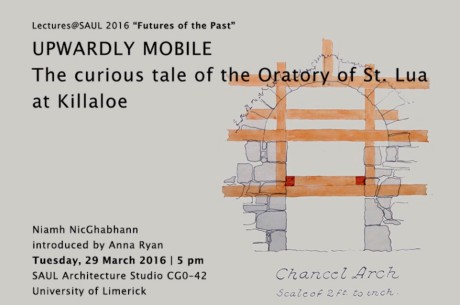Upwardly Mobile
29 March 2016 5:00 pm at SAUL Studio
Speaker: Niamh NicGhabhann introduced by Anna Ryan
This talk considers the position of Irish medieval buildings in the early years of twentieth century. Focusing on the treatment of the tiny oratory of St. Lua at Killaloe, Niamh NicGhabhann will examine the ways in which the ruins of the medieval past were used to signify a range of political, religious and cultural ideas and attitudes. The rising water levels following the Shannon Scheme works meant that this little stone oratory was moved from its
original position on Friar’s Island to the grounds of St. Flannan’s Roman Catholic Church in 1929. The resulting paper trail provides a fascinating window on the decision-making process, the values ascribed to the medieval past, and the different personalities involved in this episode. The story of St. Lua’s oratory will be considered in the context of the nineteenth-century tradition of scholarship on medieval buildings, the development of the idea of a ‘national’ Irish architecture during this period, and the impact of this tradition on subsequent engagement with the buildings of the medieval past.
Niamh NicGhabhann is Course Director for the MA Festive Arts Programme at the Irish World Academy of Music and Dance at the University of Limerick. She holds a PhD in the History of Art from Trinity College Dublin. Her research focuses on Irish studies, with an emphasis on the art and architecture of Ireland, concepts of space, memory, performance and the body. She is particularly interested in exploring these concepts through visual images, built landscapes, poetry and prose fiction. Her current research also includes work on arts management, cultural entrepreneurship and innovation, and ideas of measurement and value in the arts and cultural sector. In 2015, Four Courts Press published her book on the subject, “Medieval ecclesiastical buildings in Ireland, 1789–1915.”
“Futures of the Past” looks at buildings of the past and how we think about their future. Aware of the necessarily creative and destructive role of architecture we hold a deep interest in what exists. This series of talks is a public forum intended to address a range of questions on architecture’s role, past and present. The current suite of lectures focuses on architects in the role of curators of historic buildings as well as the technologies of preservation.

